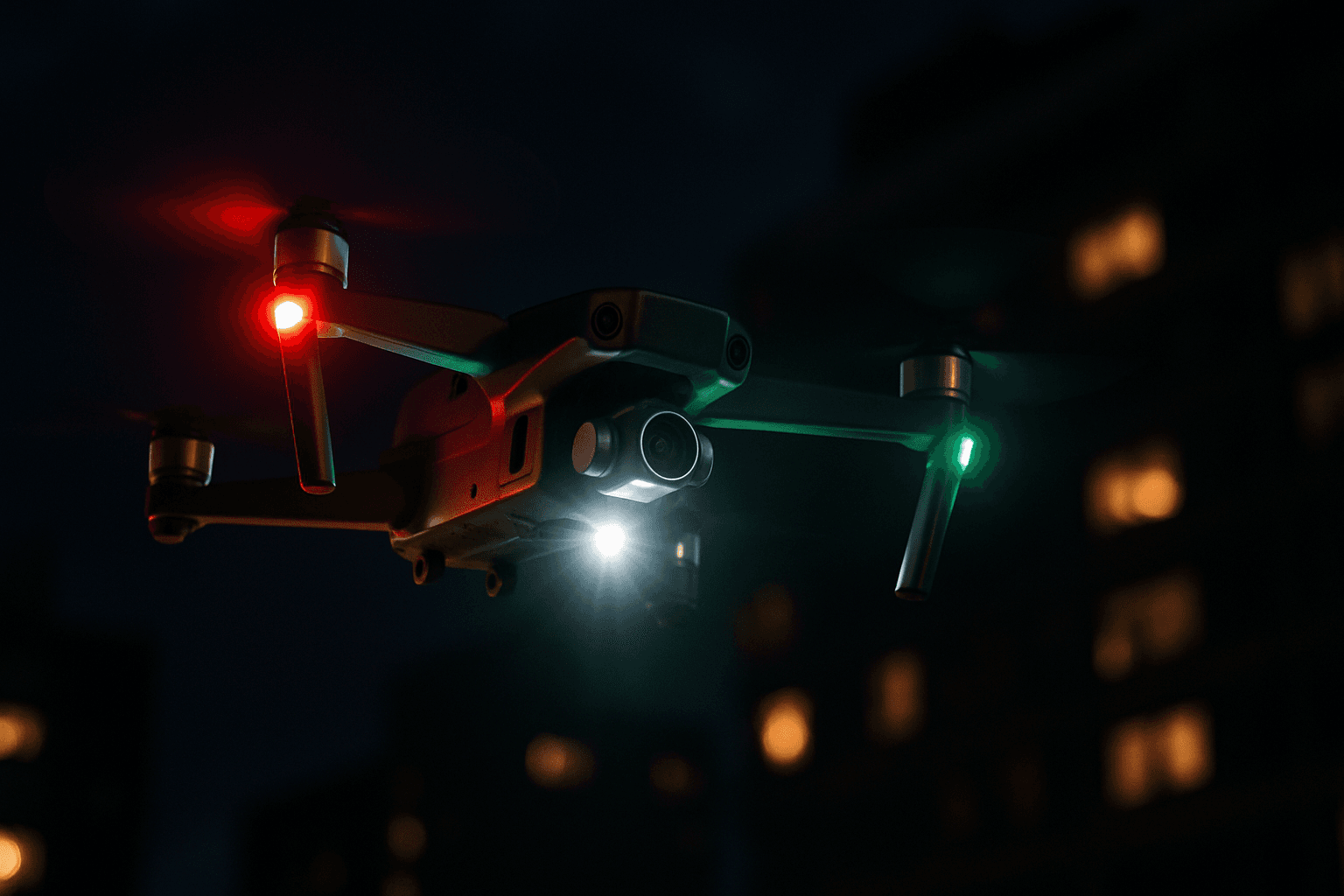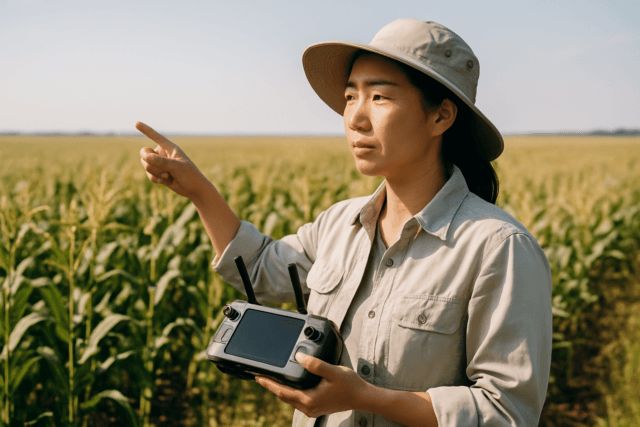Drones have become increasingly popular for both recreational and commercial use. As drone technology advances and becomes more accessible, it’s crucial to understand the regulations and best practices for safe operation, especially when flying at night. A key aspect of ensuring drone safety is the use of flashing lights, which enhance visibility and reduce the risk of collisions.
Why Drone Flashing Lights Matter
Flashing lights on drones serve several important purposes:
- Enhanced Visibility: In low-light conditions or at night, flashing lights make drones more visible to other aircraft, people on the ground, and even other drone operators.
- Collision Avoidance: By increasing visibility, flashing lights help prevent collisions with other objects in the airspace.
- Regulatory Compliance: Many aviation authorities, including the UK Civil Aviation Authority (CAA), mandate the use of flashing lights for night-time drone operations.
- Maintaining Visual Line of Sight (VLOS): Lights help the pilot maintain VLOS with the drone at night.
UK Regulations for Drone Flashing Lights
The UK CAA has specific regulations regarding drone operations at night, which include requirements for flashing lights. Here’s what you need to know:
- Night Flying is Permitted: Flying a drone at night is legal in the UK, provided you adhere to the CAA’s regulations and maintain Visual Line of Sight (VLOS) throughout the flight.
- Anti-Collision Lights: Drones operated at night must be equipped with anti-collision lights that are visible from at least 3 statute miles (approximately 4.8 kilometers).
- Green Flashing Light: UK drone laws specifically mandate at least one green flashing light that’s clearly visible from a reasonable distance.
- Maintaining VLOS: Drone lighting requirements aren’t explicitly detailed in regulations, but your lights must be sufficient to maintain VLOS at all times.
Key Points to Remember:
- Standard UK drone regulations, including the 400 feet (120 meters) Above Ground Level (AGL) height restriction, still apply during nighttime flights.
- You must continue to observe the 400 feet Above Ground Level (AGL) height limitations, maintain visual line of sight with your aircraft, and secure proper authorization for controlled airspace flights.
Choosing the Right Flashing Lights for Your Drone
When selecting flashing lights for your drone, consider the following factors:
Brightness and Visibility:
- Ensure the lights are bright enough to be seen from a sufficient distance, ideally 3+ miles to comply with regulations in certain regions.
- Look for lights with high-intensity LEDs for maximum visibility.
Color:
- While a green flashing light is often mandated, consider lights with multiple colors (white, red, green, blue) for added visibility and customization.
Weight and Size:
- Choose lightweight lights to minimize the impact on your drone’s flight time and performance.
- Compact designs are easier to mount and won’t affect the drone’s aerodynamics.
Battery Life and Charging:
- Opt for lights with a long battery life to ensure they last throughout your entire flight.
- USB-rechargeable lights are convenient and eliminate the need for disposable batteries.
Mounting Options:
- Ensure the lights can be easily and securely mounted to your drone using methods like 3M dual lock technology.
Modes and Features:
- Consider lights with different modes, such as strobe, slow flash, and solid, to suit various flying conditions and preferences.
Popular Drone Flashing Light Options
Here are some popular drone flashing light options available in the UK market:
- VIFLY Strobe: This anti-collision drone LED light offers 3+ miles visibility, meets FAA anti-collision light rules, and has 360º coverage. It features 5 bright LEDs with 3 white colors, 1 red color, and 1 green color, each with 3 modes (strobe, slow flash, and solid).
- Lume Cube Strobe: Designed to be lightweight and powerful, Lume Cube Strobes are visible from 3+ miles away and can flash white, red, or green. They have multiple light modes, including a strobe speed of 1Hz (60 strobes per minute).
- Strobon C-1: This standalone drone strobe provides a quick and hassle-free way to add anti-collision lights to your drone. It is compatible with FAA and CAA anti-collision light rules and can be seen from at least 3 miles at night.
- ACROTOR Drone Lights: These strobe LED navigation lights are compatible with a wide range of drone models and are easy to install. They offer multiple flashing patterns to suit your preferences.
- Strobon V2 Navigation Strobe Lights: These lights offer various options and can be selected based on the product page.
- HeiyRC Mini 4 Pro Drone Strobe Light: Super Bright Flash LEDs for various DJI models.
Where to Buy Drone Flashing Lights in the UK
You can purchase drone flashing lights from various online retailers and specialty drone shops in the UK, including:
- Amazon UK: Offers a wide selection of drone strobe lights from various brands.
- Unmanned Tech Shop: Specializes in drone LED lighting and navigation solutions.
- Flying Tech: Provides a range of drone lighting options, including strobes and LED strips.
- HobbyRC UK: Stocks various drone strobe lights, including the VIFLY Strobe Platinum.
- Drones Direct: Sells anti-collision lighting for drones, such as the Lume Cube Strobe 3 Pack.
- eBay UK: Offers a variety of RC navigation lights and LED strobe kits for drones.
Installing and Using Drone Flashing Lights
Installing drone flashing lights is generally a straightforward process. Here are some tips:
- Choose a Mounting Location: Select a location on your drone that provides maximum visibility from all angles. Common locations include the top, bottom, or arms of the drone.
- Secure the Lights: Use appropriate mounting hardware, such as 3M dual lock tape, to securely attach the lights to your drone.
- Connect the Power: If necessary, connect the lights to a power source on your drone. Ensure the voltage and polarity are correct.
- Test the Lights: Before each flight, test the lights to ensure they are functioning properly.
- Follow Regulations: Always comply with local regulations regarding the use of flashing lights on drones.
Best Practices for Night-Time Drone Operations
In addition to using flashing lights, follow these best practices for safe night-time drone operations:
- Pre-Flight Inspection: Conduct a thorough pre-flight inspection of your drone, including the lights, battery, and other critical systems.
- Site Reconnaissance: Perform a daytime site reconnaissance to identify potential hazards and obstacles.
- Fly in Familiar Areas: Stick to flying in areas you are familiar with, especially during night flights.
- Monitor Weather Conditions: Be aware of weather conditions, such as wind and visibility, which can affect your drone’s performance.
- Maintain Visual Line of Sight (VLOS): Always maintain VLOS with your drone.
- Fly with a Spotter: If possible, fly with a spotter who can help you monitor the drone and the surrounding airspace.
- Emergency Procedures: Have a plan in place for emergency situations, such as loss of signal or battery failure.
The Future of Drone Lighting Regulations
The UK CAA is continuously reviewing and updating drone regulations to ensure the safety and security of the airspace. Recent proposals include:
- Require flashing lights for UAS operations in the dark: The CAA wants to amend the regulation to require nighttime UAS operations to have an active flashing light, ensuring these UAS are visible in the dark.
- Implement Direct Remote ID for UAS: The CAA wants to implement Direct Remote ID product and operational requirements from January 1, 2026. These requirements would come into force for UK1, UK2, UK3, UK5, and UK6 UAS, unless exempted under a Specific Category Operational Authorisation (OA).
Staying informed about the latest regulations and best practices is essential for all drone operators.
Conclusion
Drone flashing lights are a critical component of safe and responsible drone operations, particularly at night. By understanding the UK regulations, choosing the right lights for your drone, and following best practices, you can ensure your flights are safe and compliant. As drone technology continues to evolve, staying informed and adapting to new regulations will be key to enjoying the benefits of drone flying while minimizing risks.





